Ontwikkelboards
-
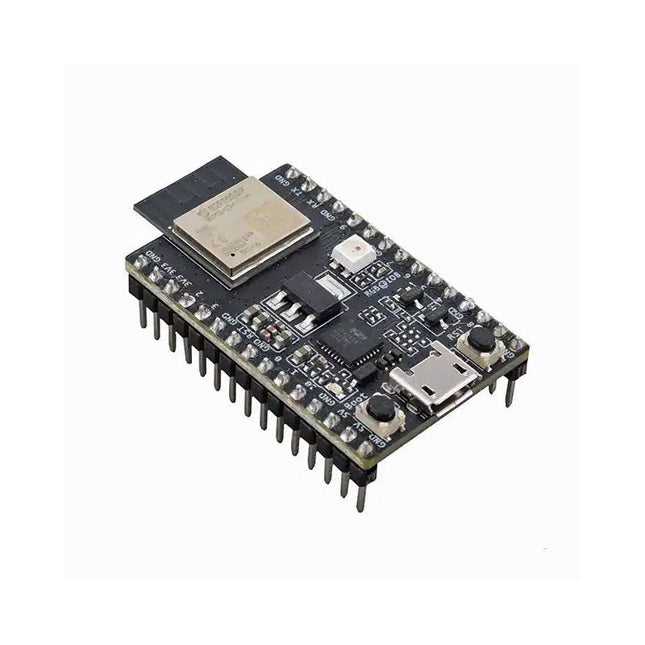
Espressif ESP32-C3-DevKitM-1
ESP32-C3-DevKitM-1 is een ontwikkelingsboard voor beginners, gebaseerd op de ESP32-C3-MINI-1, een module die zijn naam dankt aan zijn kleine afmetingen. Dit board beschikt over volledige Wi-Fi en Bluetooth LE functies. De meeste I/O-pinnen op de ESP32-C3-MINI-1 module zijn uitgesplitst naar de pin headers aan beide zijden van dit board voor eenvoudige interfacing. Ontwikkelaars kunnen randapparatuur aansluiten met jumper draden of de ESP32-C3-DevKitM-1 op een breadboard monteren. Specificaties ESP32-C3-MINI-1 ESP32-C3-MINI-1 is een universele Wi-Fi en Bluetooth LE combo-module die wordt geleverd met een PCB-antenne. Het hart van deze module is de ESP32-C3FN4, een chip met een embedded flash van 4 MB. Omdat de flash geïntegreerd is in de ESP32-C3FN4 chip, in plaats van in de module, heeft de ESP32-C3-MINI-1 een kleiner formaat. 5 V naar 3.3 V LDO Spanningsregelaar die een 5 V voeding omzet in 3,3 V. 5 V Power On LED Schakelt in wanneer de USB-voeding op het board wordt aangesloten. Pin Headers Alle beschikbare GPIO-pinnen (behalve de SPI-bus voor flash) zijn uitgesplitst naar de pin headers op het board. Zie voor details Header Block. Boot knop Downloadknop. Als je Boot ingedrukt houdt en dan op Reset drukt, start de modus Firmware Download voor het downloaden van firmware via de seriële poort. Micro-USB poort USB-interface. Voeding voor het board en de communicatie-interface tussen een computer en de ESP32-C3FN4 chip. Reset knop Druk op deze knop om het systeem opnieuw op te starten. USB-to-UART Bridge Single USB-UART bridge chip biedt overdrachtssnelheden tot 3 Mbps. RGB LED Adresseerbare RGB LED, aangestuurd door GPIO 8. Downloads ESP32-C3 Datasheet ESP32-C3-MINI-1 Datasheet ESP32-C3-DevKitM-1 Schematic ESP32-C3-DevKitM-1 PCB Layout ESP32-C3-DevKitM-1 Dimensions
€ 19,95€ 9,95
Leden identiek
-

Nordic Semiconductor Nordic Semiconductor nRF52840 USB Dongle
The nRF52840 Dongle is a small, low-cost USB dongle that supports Bluetooth 5.3, Bluetooth mesh, Thread, ZigBee, 802.15.4, ANT and 2.4 GHz proprietary protocols. The Dongle is the perfect target hardware for use with nRF Connect for Desktop as it is low-cost but still support all the short range wireless standards used with Nordic devices. The dongle has been designed to be used as a wireless HW device together with nRF Connect for Desktop. For other use cases please do note that there is no debug support on the Dongle, only support for programming the device and communicating through USB. It is supported by most of the nRF Connect for Desktop apps and will automatically be programmed if needed. In addition custom applications can be compiled and downloaded to the Dongle. It has a user programmable RGB LED, a green LED, a user programmable button as well as 15 GPIO accessible from castellated solder points along the edge. Example applications are available in the nRF5 SDK under the board name PCA10059. The nRF52840 Dongle is supported by nRF Connect for Desktop as well as programming through nRFUtil. Features Bluetooth 5.2 ready multiprotocol radio 2 Mbps Long Range Advertising Extensions Channel Selection Algorithm #2 (CSA #2) IEEE 802.15.4 radio support Thread ZigBee Arm Cortex-M4 with floating point support DSP instruction set ARM CryptoCell CC310 cryptographic accelerator 15 GPIO available via edge castellation USB interface direct to nRF52840 SoC Integrated 2.4 GHz PCB antenna 1 user-programmable button 1 user-programmable RGB LED 1 user-programmable LED 1.7-5.5 V operation from USB or external Downloads Datasheet Hardware Files
€ 19,95€ 9,95
Leden identiek
-
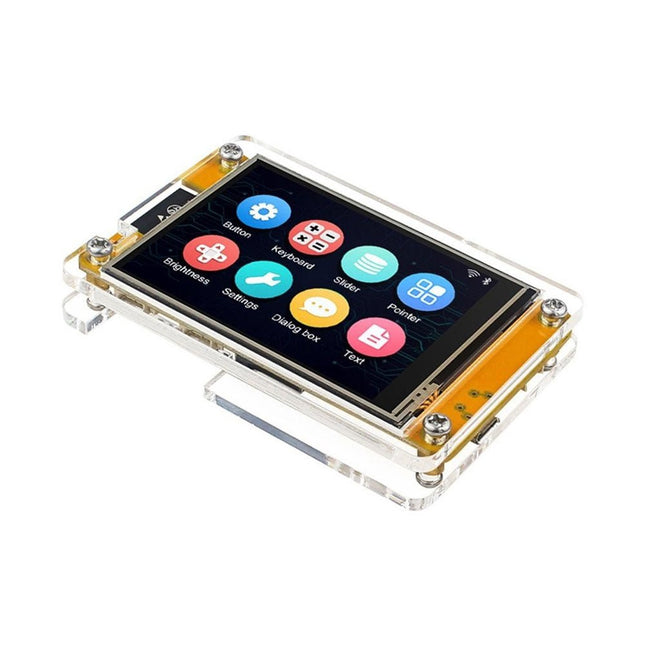
Generic ESP32 Cheap Yellow Display Board
Dit ontwikkelbord (ook bekend als "Cheap Yellow Display") wordt aangedreven door de ESP-WROOM-32, een dual-core MCU met geïntegreerde Wi-Fi- en Bluetooth-mogelijkheden. Het werkt op een hoofdfrequentie tot 240 MHz, met 520 KB SRAM, 448 KBROM en 4 MB Flash-geheugen. Het bord is voorzien van een 2,8-inch scherm met een resolutie van 240 x 320 en resistieve aanraking. Bovendien bevat het bord een achtergrondverlichtingsbesturingscircuit, aanraakbesturingscircuit, luidsprekeraandrijfcircuit, lichtgevoelig circuit en RGB-LED-besturingscircuit. Het biedt ook een TF-kaartsleuf, seriële interface, DHT11 temperatuur- en vochtigheidssensorinterface en extra IO-poorten. De module ondersteunt ontwikkeling in Arduino IDE, ESP-IDE, MicroPython en Mixly. Toepassingen Beeldoverdracht voor Smart Home-apparaat Draadloze bewaking Slimme landbouw Draadloze QR-herkenning Signaal van draadloos positioneringssysteem En andere IoT-toepassingen Specificaties Microcontroller ESP-WROOM-32 (Dual-core MCU met geïntegreerde Wi-Fi en Bluetooth) Frequentie Tot 240 MHz (rekenkracht is maximaal 600 DMIPS) SRAM 520 KB ROM 448 KB Flash 4 MB Bedrijfsspanning 5 V Stroomverbruik ca. 115 mA Display 2,8" TFT-kleurenscherm (240 x 320) Touch Resistief Touch Driver chip ILI9341 Afmetingen 50 x 86 mm Gewicht 50 g Inbegrepen 1x ESP32 Dev Board met 2,8" display en acryl-behuizing 1x Touchpen 1x Aansluitkabel 1x USB-kabel Downloads GitHub
€ 24,95
Leden € 22,46
-

Pinecone Pinecone BL602 Evaluation Board
Features Build in USB to Serial interface Build-in PCB antenna Powered by Pineseed BL602 SoC using Pinenut model: 12S stamp 2 MB Flash USB-C connection Suitable to breadboard BIY project On board three color LEDs output Dimensions: 25.4 x 44.0 mm Note: USB cable is not included.
€ 8,95€ 4,50
Leden identiek
-
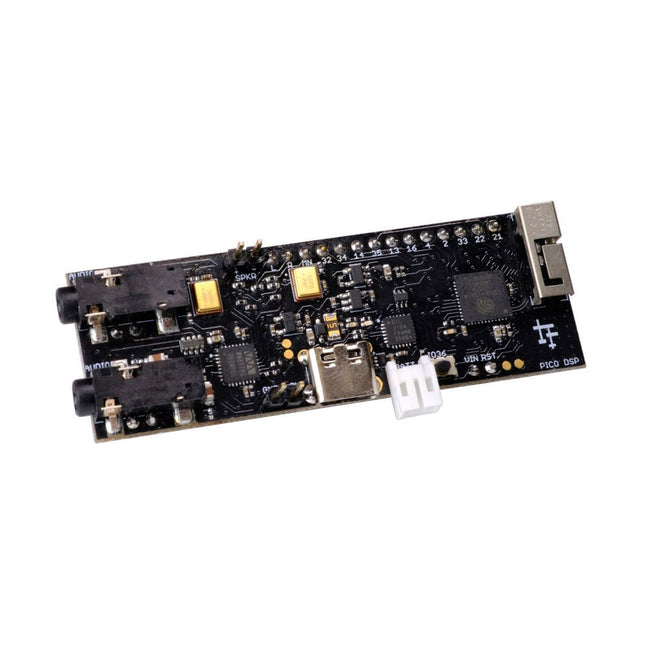
Ohmic PÚCA DSP ESP32 Development Board
PÚCA DSP is an open-source, Arduino-compatible ESP32 development board for audio and digital signal processing (DSP) applications with expansive audio-processing features. It provides audio inputs, audio outputs, a low-noise microphone array, an integrated test-speaker option, additional memory, battery-charge management, and ESD protection all on a small, breadboard-friendly PCB. Synthesizers, Installations, Voice UI, and More PÚCA DSP can be used for a wide range of DSP applications, including but not limited to those in the fields of music, art, creative technology, and adaptive technology. Music-related examples include digital-music synthesis, mobile recording, Bluetooth speakers, wireless line-level directional microphones, and the design of smart musical instruments. Art-related examples include acoustic sensor networks, sound-art installations, and Internet-radio applications. Examples related to creative and adaptive technology include voice user interface (VUI) design and Web audio for the Internet of Sounds. Compact, Integrated Design PÚCA DSP was designed for portability. When used with an external 3.7 V rechargeable battery, it can be deployed almost anywhere or integrated into just about any device, instrument, or installation. Its design emerged from months of experimentation with various ESP32 development boards, DAC breakout boards, ADC breakout boards, Microphone breakout boards, and audio-connector breakout boards, and – despite its diminutive size – it manages to provide all of that functionality in a single board. And it dos so without compromising signal quality. Specifications Processor & Memory Espressif ESP32 Pico D4 Processor 32-bit dual core 80 MHz / 160 MHz / 240 MHz 4 MB SPI Flash with 8 MB additional PSRAM (Original Edition) Wireless 2.4 GHz Wi-Fi 802.11b/g/n Bluetooth BLE 4.2 3D Antenna Audio Wolfson WM8978 Stereo Audio Codec Audio Line In on 3.5 mm stereo onnector Audio Headphone / Line Out on 3.5 mm stereo connector Stereo Aux Line In, Audio Mono Out routed to GPIO Header 2x Knowles SPM0687LR5H-1 MEMS Microphones ESD protection on all audio inputs and outputs Support for 8, 11.025, 12, 16, 22.05, 24, 32, 44.1 and 48 kHz sample rates 1 W Speaker Driver, routed to GPIO Header DAC SNR 98 dB, THD -84 dB (‘A’ weighted @ 48 kHz) ADC SNR 95 dB, THD -84 dB (‘A’ weighted @ 48 kHz) Line input impedance: 1 MOhm Line output impedance: 33 Ohm Form Factor and Connectivity Breadboard friendly 70 x 24 mm 11x GPIO pins broken out to 2.54 mm pitch header, with access to both ESP32 ADC channels, JTAG and capacitive touch pins USB 2.0 over USB Type C connector Power 3.7/4.2 V Lithium Polymer Rechargeable Battery, USB or external 5 V DC power source ESP32 and Audio Codec can be placed into low power modes under software control Battery voltage level detection ESD protection on USB data bus Downloads GitHub Datasheet Links Crowd Supply Campaign (includes FAQs) Hardware Overview Programming the Board The Audio Codec
€ 69,95€ 34,95
Leden identiek
-
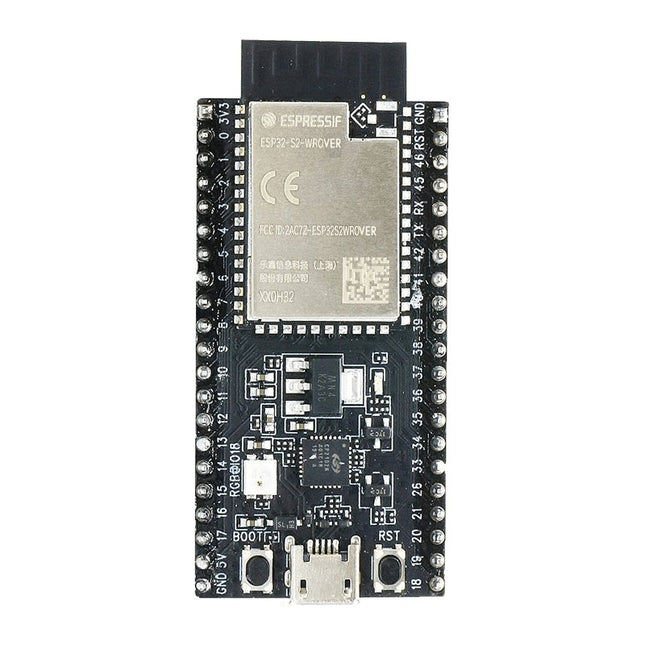
Espressif ESP32-S2-Saola-1R Development Board
ESP32-S2-Saola-1R is a small-sized ESP32-S2 based development board. Most of the I/O pins are broken out to the pin headers on both sides for easy interfacing. Developers can either connect peripherals with jumper wires or mount ESP32-S2-Saola-1R on a breadboard.ESP32-S2-Saola-1R is equipped with the ESP32-S2-WROVER module, a powerful, generic Wi-Fi MCU module that has a rich set of peripherals. It is an ideal choice for a wide variety of application scenarios relating to Internet of Things (IoT), wearable electronics and smart home. The board a PCB antenna and features a 4 MB external SPI flash and an additional 2 MB SPI Pseudo static RAM (PSRAM).FeaturesMCU ESP32-S2 embedded, Xtensa® single-core 32-bit LX7 microprocessor, up to 240 MHz 128 KB ROM 320 KB SRAM 16 KB SRAM in RTC WiFi 802.11 b/g/n Bit rate: 802.11n up to 150 Mbps A-MPDU and A-MSDU aggregation 0.4 µs guard interval support Center frequency range of operating channel: 2412 ~ 2484 MHz Hardware Interfaces: GPIO, SPI, LCD, UART, I²C, I²S, Camera interface, IR, pulse counter, LED PWM, TWAI (compatible with ISO 11898-1), USB OTG 1.1, ADC, DAC, touch sensor, temperature sensor 40 MHz crystal oscillator 4 MB SPI flash Operating voltage/Power supply: 3.0 ~ 3.6 V Operating temperature range: –40 ~ 85 °C Dimensions: 18 × 31 × 3.3 mm Applications Generic Low-power IoT Sensor Hub Generic Low-power IoT Data Loggers Cameras for Video Streaming Over-the-top (OTT) Devices USB Devices Speech Recognition Image Recognition Mesh Network Home Automation Smart Home Control Panel Smart Building Industrial Automation Smart Agriculture Audio Applications Health Care Applications Wi-Fi-enabled Toys Wearable Electronics Retail & Catering Applications Smart POS Machines
€ 22,95€ 11,50
Leden identiek
-
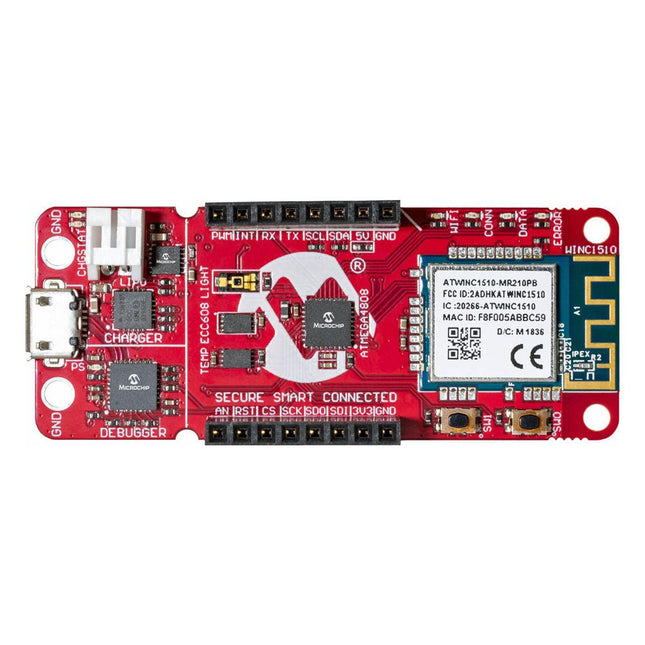
Microchip Microchip AVR-IoT WA Development Board
The AVR-IoT WA development board combines a powerful ATmega4808 AVR MCU, an ATECC608A CryptoAuthentication™ secure element IC and the fully certified ATWINC1510 Wi-Fi network controller – which provides the most simple and effective way to connect your embedded application to Amazon Web Services (AWS). The board also includes an on-board debugger, and requires no external hardware to program and debug the MCU.Out of the box, the MCU comes preloaded with a firmware image that enables you to quickly connect and send data to the AWS platform using the on-board temperature and light sensors. Once you are ready to build your own custom design, you can easily generate code using the free software libraries in Atmel START or MPLAB Code Configurator (MCC).The AVR-IoT WA board is supported by two award-winning Integrated Development Environments (IDEs) – Atmel Studio and Microchip MPLAB X IDE – giving you the freedom to innovate with your environment of choice.Features ATmega4808 microcontroller Four user LED’s Two mechanical buttons mikroBUS header footprint TEMT6000 Light sensor MCP9808 Temperature sensor ATECC608A CryptoAuthentication™ device WINC1510 WiFi Module On-board Debugger Auto-ID for board identification in Atmel Studio and Microchip MPLAB X One green board power and status LED Programming and debugging Virtual COM port (CDC) Two DGI GPIO lines USB and battery powered Integrated Li-Ion/LiPo battery charger
€ 39,95€ 19,95
Leden identiek
-
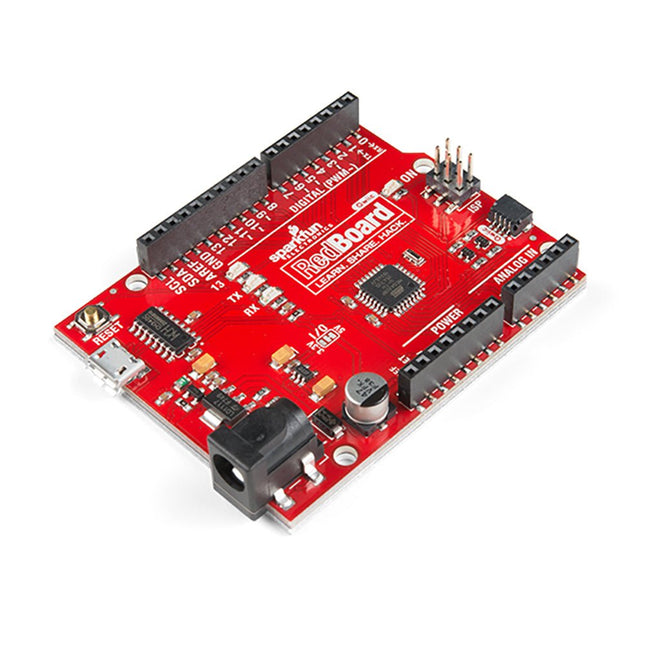
SparkFun SparkFun RedBoard Qwiic
Features ATmega328 microcontroller met Optiboot Bootloader R3 Shield Compatible CH340C serieel-USB-converter 3.3 V tot 5 V Spanningsniveau Jumper A4 / A5 jumpers AP2112 spanningsregelaar ISP-kopje Ingangsspanning: 7 V - 15 V 1 Qwiic aansluiting 16 MHz kloksnelheid 32 k Flash-geheugen Alle SMD constructie verbeterde resetknop
€ 27,95€ 13,95
Leden identiek
-

Farnell element14 OKdo E1 Development Board
The OKdo E1 is an ultra-low-cost Development Board based on the NXP LPC55S69JBD100 dual-core Arm Cortex-M33 microcontroller. The E1 board is perfect for Industrial IoT, building control and automation, consumer electronics, general embedded and secure applications. Features Processor with Arm TrustZone, Floating Point Unit (FPU) and Memory Protection Unit (MPU) CASPER Crypto co-processor to enable hardware acceleration for certain asymmetric cryptographic algorithms PowerQuad Hardware Accelerator for fixed and floating point DSP functions SRAM Physical Unclonable Function (PUF) for key generation, storage and reconstruction PRINCE module for real-time encryption and decryption of flash data AES-256 and SHA2 engines Up to Nine Flexcomm interfaces. Each Flexcomm interface can be selected by software to be a USART, SPI, I²C, and I²S interface USB 2.0 High-Speed Host/Device controller with on-chip PHY USB 2.0 Full-Speed Host/Device controller with on-chip PHY Up to 64 GPIOs Secure digital input/output (SD/MMC and SDIO) card interface Specifications LPC55S69JBD100 640kbyte flash microcontroller In-built CMSIS-DAP v1.0.7 debugger based on LPC11U35 Internal PLL support up to 100MHz operation, 16MHz can be mounted for full 150MHz operation. SRAM 320kB 32kHz crystal for real-time clock 4 user switches 3-colour LED User USB connector 2-off 16-way expansion connectors UART over USB virtual COM port
€ 24,95€ 12,50
Leden identiek
-

Luckfox LuckFox Pico Mini B Linux Micro Development Board (met Headers)
LuckFox Pico Mini is een compact Linux-micro-ontwikkelbord gebaseerd op de Rockchip RV1103-chip en biedt een eenvoudig en efficiënt ontwikkelingsplatform voor ontwikkelaars. Het ondersteunt een verscheidenheid aan interfaces, waaronder MIPI CSI, GPIO, UART, SPI, I²C, USB, enz., wat handig is voor snelle ontwikkeling en foutopsporing. Kenmerken Single-core ARM Cortex-A7 32-bit kern met geïntegreerde NEON en FPU Ingebouwde, door Rockchip zelf ontwikkelde NPU van de 4e generatie, beschikt over een hoge computerprecisie en ondersteunt int, int8 en int16 hybride kwantisering. De rekenkracht van int8 is 0,5 TOPS, en tot 1,0 TOPS met int4 Ingebouwde, zelfontwikkelde ISP3.2 van de derde generatie, ondersteunt 4-megapixel, met meerdere beeldverbeterings- en correctie-algoritmen zoals HDR, WDR, ruisonderdrukking op meerdere niveaus, enz. Beschikt over krachtige coderingsprestaties, ondersteunt intelligente coderingsmodus en adaptieve streambesparing afhankelijk van de scène, bespaart meer dan 50% bitsnelheid van de conventionele CBR-modus, zodat de beelden van de camera high-definition zijn met een kleiner formaat, dubbele opslag spatie Ingebouwde RISC-V MCU ondersteunt een laag stroomverbruik en snel opstarten, ondersteunt 250 ms snelle beeldopname en laden van de AI-modelbibliotheek tegelijkertijd om gezichtsherkenning "in één seconde" te realiseren Ingebouwde 16-bit DRAM DDR2, die veeleisende geheugenbandbreedtes kan ondersteunen Geïntegreerd met ingebouwde POR, audiocodec en MAC PHY Specificaties Processor ARM Cortex-A7, single-core 32-bit CPU, 1,2 GHz, met NEON en FPU NPU Rockchip 4e generatie NPU, ondersteunt int4, int8, int16; tot 1,0 TOPS (int4) ISP Derde generatie ISP3.2, invoer tot 4 MP bij 30 fps, HDR, WDR, ruisonderdrukking RAM 64 MB DDR2 Geheugen 128 MB SPI NAND-flash USB USB 2.0-host/apparaat via Type-C Camera-interface MIPI CSI 2-baans GPIO-pinnen 17 GPIO-pinnen Stroomverbruik Laag stroomverbruik, RISC-V MCU voor snel opstarten Afmetingen 28 x 21 mm Downloads Wiki
€ 19,95€ 9,95
Leden identiek
-

Waveshare QuecPython EC200U-EU C4-P01 Development Board
The EC200U-EU C4-P01 development board features the EC200U-EU LTE Cat 1 wireless communication module, offering a maximum data rate of up to 10 Mbps for downlink and 5 Mbps for uplink. It supports multi-mode and multi-band communication, making it a cost-effective solution. The board is designed in a compact and unified form factor, compatible with the Quectel multi-mode LTE Standard EC20-CE. It includes an onboard USB-C port, allowing for easy development with just a USB-C cable. Additionally, the board is equipped with a 40-pin GPIO header that is compatible with most Raspberry Pi HATs. Kenmerken Equipped with EC200U-EU LTE Cat 1 wireless communication module, multi-mode & multi-band support Onboard 40-Pin GPIO header, compatible with most Raspberry Pi HATs 5 LEDs for indicating module operating status Supports TCP, UDP, PPP, NITZ, PING, FILE, MQTT, NTP, HTTP, HTTPS, SSL, FTP, FTPS, CMUX, MMS protocols, etc. Supports GNSS positioning (GPS, GLONASS, BDS, Galileo, QZSS) Onboard Nano SIM card slot and eSIM card slot, dual card single standby Onboard MIPI connector for connecting MIPI screen and is fully compatible with Raspberry Pi peripherals Onboard camera connector, supports customized SPI cameras with a maximum of 300,000 pixels Provides tools such as QPYcom, Thonny IDE plugin, and VSCode plugin, etc. for easy learning and development Comes with online development resources and manual (example in QuecPython) Specificaties Applicable Regions Europe, Middle East, Africa, Australia, New Zealand, Brazil LTE-FDD B1, B3, B5, B7, B8, B20, B28 LTE-TDD B38, B40, B41 GSM / GPRS / EDGE GSM: B2, B3, B5, B8 GNSS GPS, GLONASS, BDS, Galileo, QZSS Bluetooth Bluetooth 4.2 (BR/EDR) Wi-Fi Scan 2.4 GHz 11b (Rx) CAT 1 LTE-FDD: DL 10 Mbps; UL 5 Mbps LTE-TDD: DL 8.96 Mbps; UL 3.1 Mbps GSM / GPRS / EDGE GSM: DL 85.6 Kbps; UL 85.6 Kbps USB-C Port Supports AT commands testing, GNSS positioning, firmware upgrading, etc. Communication Protocol TCP, UDP, PPP, NITZ, PING, FILE, MQTT, NTP, HTTP, HTTPS, SSL, FTP, FTPS, CMUX, MMS SIM Card Nano SIM and eSIM, dual card single standby Indicator P01: Module Pin 1, default as EC200A-XX PWM0 P05: Module Pin 5, NET_MODE indicator SCK1: SIM1 detection indicator, lights up when SIM1 card is inserted SCK2: SIM2 detection indicator, lights up when SIM2 card is inserted PWR: Power indicator Buttons PWK: Power ON/OFF RST: Reset BOOT: Forcing into firmware burning mode USB ON/OFF: USB power consumption detection switch Antenna Connectors LTE main antenna + DIV / WiFi (scanning only) / Bluetooth antenna + GNSS antenna Operating Temperature −30~+75°C Storage Temperature −45~+90°C Downloads Wiki Quectel Resources
€ 69,95€ 34,95
Leden identiek
-

milkV Milk-V Duo 256M RISC-V Singe-board Computer
De Milk-V Duo 256M is een ultracompact embedded ontwikkelplatform gebaseerd op de SG2002-chip. Het kan Linux en RTOS draaien en biedt een betrouwbaar, goedkoop en krachtig platform voor professionals, industriële ODM's, AIoT-enthousiastelingen, doe-het-zelf-hobbyisten en makers. Dit bord is een verbeterde versie van Duo met een geheugenboost tot 256 MB, geschikt voor toepassingen die grotere geheugencapaciteiten vereisen. De SG2002 verhoogt de rekenkracht naar 1,0 TOPS @ INT8. Het maakt naadloos schakelen tussen RISC-V/ARM-architecturen mogelijk en ondersteunt gelijktijdige werking van dubbele systemen. Bovendien bevat het een reeks rijke GPIO-interfaces zoals SPI, UART, geschikt voor een breed scala aan hardwareontwikkelingen op het gebied van intelligente monitoring, waaronder IP-camera's, slimme kijkgaatjes, visuele deurbellen en meer. SG2002 is een krachtige chip met laag vermogen, ontworpen voor verschillende productgebieden, zoals intelligente IP-bewakingscamera's, slimme deursloten, visuele deurbellen en huisintelligentie. Het integreert H.264-videocompressie en -decodering, H.265-videocompressiecodering en ISP-mogelijkheden. Het ondersteunt meerdere beeldverbeterings- en correctie-algoritmen, zoals HDR breed dynamisch bereik, 3D-ruisonderdrukking, ontwaseming en lensvervormingscorrectie, waardoor klanten professionele videobeeldkwaliteit krijgen. De chip bevat ook een zelfontwikkelde TPU, die 1,0 TOPS aan rekenkracht levert bij 8-bit integer-bewerkingen. De speciaal ontworpen TPU-planningsengine zorgt op efficiënte wijze voor een gegevensstroom met hoge bandbreedte voor alle kernen van de tensorverwerkingseenheden. Bovendien biedt het gebruikers een krachtige deep learning-modelcompiler en software-SDK-ontwikkelkit. Toonaangevende deep learning-frameworks zoals Caffe en Tensorflow kunnen eenvoudig naar het platform worden geporteerd. Bovendien omvat het security boot, veilige updates en encryptie, waardoor een reeks beveiligingsoplossingen wordt geboden, van ontwikkeling, massaproductie tot producttoepassingen. De chip integreert een 8-bit MCU-subsysteem, dat de typische externe MCU vervangt om kostenbesparingen en energie-efficiëntiedoelen te bereiken. Specificaties SoC SG2002 RISC-V CPU C906 @ 1 Ghz + C906 @ 700 MHz Arm CPU 1x Cortex-A53 @ 1 GHz MCU 8051 @ 6 KB SRAM Geheugen 256 MB SIP-DRAM TPU 1.0 TOPS @ INT8 Opslag 1x microSD-connector of 1x SD NAND aan boord USB 1x USB-C voor voeding en data, USB-pads beschikbaar CSI 1x 16P FPC-connector (MIPI CSI 2-baans) Sensorondersteuning 5 M @ 30 fps Ethernet 100 Mbps Ethernet met PHY Audio Via GPIO-pads GPIO Tot 26x GPIO-pads Voeding 5 V/1 A OS-ondersteuning Linux, RTOS Afmetingen 21 x 51 mm Downloads Documentation GitHub
€ 32,95€ 16,50
Leden identiek
-

Luckfox LuckFox Pico Ultra Development Board
De LuckFox Pico Ultra is een compacte single-board computer (SBC) die wordt aangestuurd door de Rockchip RV1106G3-chipset, ontworpen voor AI-verwerking, multimedia en low-power embedded-toepassingen. Hij is uitgerust met een ingebouwde 1 TOPS NPU, waardoor hij ideaal is voor edge AI-werklasten. Met 256 MB RAM, 8 GB onboard eMMC-opslag, geïntegreerde wifi en ondersteuning voor de LuckFox PoE-module levert het bord zowel prestaties als veelzijdigheid in een breed scala aan use cases. De LuckFox Pico Ultra draait op Linux en ondersteunt verschillende interfaces, waaronder MIPI CSI, RGB LCD, GPIO, UART, SPI, I²C en USB. Dit biedt een eenvoudig en efficiënt ontwikkelplatform voor toepassingen in smart home, industriële besturing en IoT. Specificaties Chip Rockchip RV1106G3 Processor Cortex A7 1,2 GHz Neurale netwerkprocessor (NPU) 1 TOPS, ondersteunt int4, int8, int16 Beeldprocessor (ISP) Max. invoer 5M @30fps Geheugen 256 MB DDR3L WiFi + Bluetooth 2,4GHz WiFi-6 Bluetooth 5.2/BLE Camera-interface MIPI CSI 2-lane DPI-interface RGB666 PoE-interface IEEE 802.3af PoE Luidsprekerinterface MX1,25 mm USB USB 2.0-host/apparaat GPIO 30 GPIO pinnen Ethernet 10/100M Ethernet-controller en ingebedde PHY Standaardopslagmedium eMMC (8 GB) Inbegrepen 1x LuckFox Pico Ultra W 1x LuckFox PoE module 1x IPX 2.4G 2 db-antenne 1x USB-A naar USB-C kabel 1x Schroevenpakket Downloads Wiki
€ 39,95€ 19,95
Leden identiek
-

NXP Semiconductors NXP FRDM-MCXN947 Development Board
The FRDM-MCXN947 is a compact and versatile development board designed for rapid prototyping with MCX N94 and N54 microcontrollers. It features industry-standard headers for easy access to the MCU's I/Os, integrated open-standard serial interfaces, external flash memory, and an onboard MCU-Link debugger. Specificaties Microcontroller MCX-N947 Dual Arm Cortex-M33 cores @ 150 MHz each with optimized performance efficiency, up to 2 MB dual-bank flash with optional full ECC RAM, External flash Accelerators: Neural Processing Unit, PowerQuad, Smart DMA, etc. Memory Expansion *DNP Micro SD card socket Connectivity Ethernet Phy and connector HS USB-C connectors SPI/I²C/UART connector (PMOD/mikroBUS, DNP) WiFi connector (PMOD/mikroBUS, DNP) CAN-FD transceiver Debug On-board MCU-Link debugger with CMSIS-DAP JTAG/SWD connector Sensor P3T1755 I³C/I²C Temp Sensor, Touch Pad Expansion Options Arduino Header (with FRDM expansion rows) FRDM Header FlexIO/LCD Header SmartDMA/Camera Header Pmod *DNP mikroBUS User Interface RGB user LED, plus Reset, ISP, Wakeup buttons Inbegrepen 1x FRDM-MCXN947 Development Board 1x USB-C Cable 1x Quick Start Guide Downloads Datasheet Block diagram
€ 29,95€ 14,95
Leden identiek
-

SparkFun SparkFun RP2040 mikroBUS Development Board
The SparkFun RP2040 mikroBUS Development Board is a low-cost, high performance platform with flexible digital interfaces featuring the Raspberry Pi Foundation's RP2040 microcontroller. Besides the Thing Plus or Feather PTH pin layout, the board also includes a microSD card slot, 16 MB (128 Mbit) flash memory, a JST single cell battery connector (with a charging circuit and fuel gauge sensor), an addressable WS2812 RGB LED, JTAG PTH pins, four (4-40 screw) mounting holes, our signature Qwiic connectors, and a mikroBUS socket. The mikroBUS standard was developed by MikroElektronika. Similar to Qwiic and MicroMod interfaces, the mikroBUS socket provides a standardized connection for add-on Click boards to be attached to a development board and is comprised of a pair of 8-pin female headers with a standardized pin configuration. The pins consist of three groups of communications pins (SPI, UART and I²C), six additional pins (PWM, Interrupt, Analog input, Reset and Chip select), and two power groups (3.3 V and 5 V). The RP2040 is supported with both C/C++ and MicroPython cross-platform development environments, including easy access to runtime debugging. It has UF2 boot and floating-point routines baked into the chip. While the chip has a large amount of internal RAM, the board includes an additional 16 MB of external QSPI flash memory to store program code. The RP2040 contains two ARM Cortex-M0+ processors (up to 133 MHz) and features: 264 kB of embedded SRAM in six banks 6 dedicated IO for SPI Flash (supporting XIP) 30 multifunction GPIO: Dedicated hardware for commonly used peripherals Programmable IO for extended peripheral support Four 12-bit ADC channels with internal temperature sensor (up to 0.5 MSa/s) USB 1.1 Host/Device functionality Features (SparkFun RP2040 mikroBUS Dev. Board) Raspberry Pi Foundation's RP2040 microcontroller 18 Multifunctional GPIO Pins Four available 12-bit ADC channels with internal temperature sensor (500kSa/s) Up to eight 2-channel PWM Up to two UARTs Up to two I²C buses Up to two SPI buses Thing Plus (or Feather) Pin Layout: 28 PTH Pins USB-C Connector: USB 1.1 Host/Device functionality 2-pin JST Connector for a LiPo Battery (not included): 500mA charging circuit 4-pin JST Qwiic Connector LEDs: PWR - Red 3.3V power indicator CHG - Yellow battery charging indicator 25 - Blue status/test LED (GPIO 25) WS2812 - Addressable RGB LED (GPIO 08) Buttons: Boot Reset JTAG PTH Pins 16MB QSPI Flash Memory µSD Card Slot mikroBUS Socket Dimensions: 3.7' x 1.2' Four Mounting Holes: 4-40 screw compatible Downloads Schematic Eagle Files Board Dimensions Hookup Guide Qwiic Info Page GitHub Hardware Repository
€ 19,95€ 9,95
Leden identiek
-
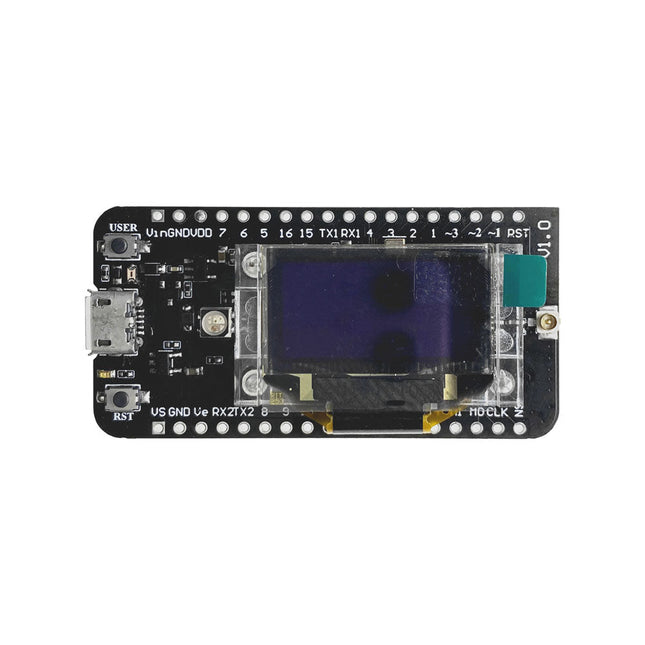
Heltec Automation CubeCell HTCC-AB02S LoRa Development Board with GPS (EU868)
The CubeCell series is designed primarily for LoRa/LoRaWAN node applications. Built on the ASR605x platform (ASR6501, ASR6502), these chips integrate the PSoC 4000 series MCU (ARM Cortex-M0+ Core) with the SX1262 module. The CubeCell series offers seamless Arduino compatibility, stable LoRaWAN protocol operation, and straightforward connectivity with lithium batteries and solar panels. The HTCC-AB02S is a developer-friendly board with an integrated AIR530Z GPS module, ideal for quickly testing and validating communication solutions. Features Arduino compatible Based on ASR605x (ASR6501, ASR6502), those chips are already integrated the PSoC 4000 series MCU (ARM Cortex M0+ Core) and SX1262 LoRaWAN 1.0.2 support Ultra low power design, 21 uA in deep sleep Onboard SH1.25-2 battery interface, integrated lithium battery management system (charge and discharge management, overcharge protection, battery power detection, USB/battery power automatic switching) Good impendence matching and long communication distance Onboard solar energy management system, can directly connect with a 5.5~7 V solar panel Micro USB interface with complete ESD protection, short circuit protection, RF shielding, and other protection measures Integrated CP2102 USB to serial port chip, convenient for program downloading, debugging information printing Onboard 0.96-inch 128x64 dot matrix OLED display, which can be used to display debugging information, battery power, and other information Using Air530 GPS module with GPS/Beidou Dual-mode position system support Specifications Main Chip ASR6502 (48 MHz ARM Cortex-M0+ MCU) LoRa Chipset SX1262 Frequency 863~870 MHz Max. TX Power 22 ±1 dBm Max. Receiving Sensitivity −135 dBm Hardware Resource 2x UART1x SPI2x I²C1x SWD3x 12-bit ADC input8-channel DMA engine16x GPIO Memory 128 Kb FLASH16 Kb SRAM Power consumption Deep sleep 21 uA Interfaces 1x Micro USB1x LoRa Antenna (IPEX)2x (15x 2.54 Pin header) + 3x (2x 2.54 Pin header) Battery 3.7 V lithium battery (power supply and charging) Solar Energy VS pin can be connected to 5.5~7 V solar panel USB to Serial Chip CP2102 Display 0.96" OLED (128 x 64) Operating temperature −20~70°C Dimensions 55.9 x 27.9 x 9.5 mm Included 1x CubeCell HTCC-AB02S Development Board 1x Antenna 1x 2x SH1.25 battery connector Downloads Datasheet Schematic GPS module (Manual) Quick start GitHub
€ 49,95€ 24,95
Leden identiek
-
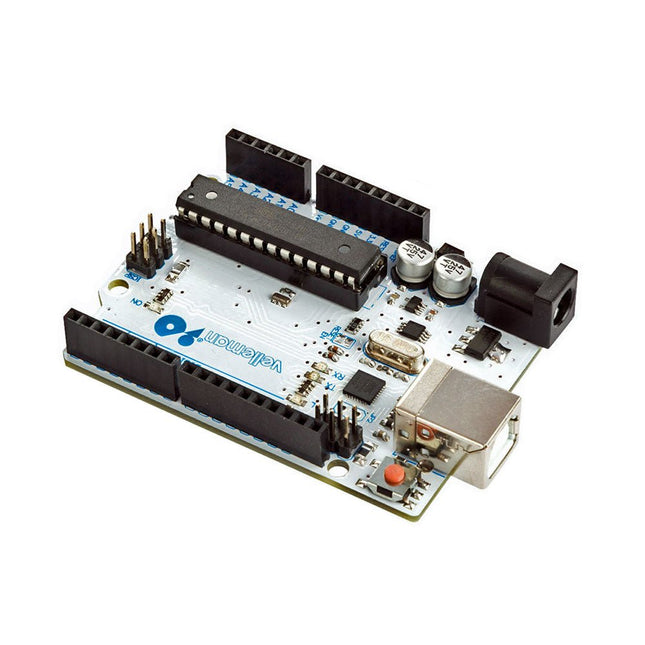
Velleman Velleman ATmega328 Uno Development Board
Het ATmega328 Uno Development Board (compatibel met Arduino Uno) is een microcontrollerbord gebaseerd op de ATmega328. Hij heeft 14 digitale in-/uitgangspinnen (waarvan 6 kunnen worden gebruikt als PWM-uitgangen), 6 analoge ingangen, een 16 MHz keramische resonator, een USB-aansluiting, een stroomaansluiting, een ICSP-header en een resetknop. Het bevat alles wat nodig is om de microcontroller te ondersteunen; sluit hem aan op een computer met een USB-kabel of voorzie hem van stroom met een AC-naar-DC-adapter of batterij om aan de slag te gaan. Specificaties Microcontroller ATmega328 Bedrijfsspanning 5 V gelijkstroom Ingangsspanning (aanbevolen) 7-12 V gelijkstroom Ingangsspanning (limieten) 6-20 V gelijkstroom Digitale I/O-pinnen 14 (waarvan 6 PWM-uitvoer leveren) Analoge ingangspinnen 6 SRAM 2 kB (ATmega328) EEPROM 1 kB (ATmega328) Flash-geheugen 32 kB (ATmega328) waarvan 0,5 kB gebruikt door bootloader Kloksnelheid 16 MHz Downloads Manual
€ 22,95€ 11,50
Leden identiek
-
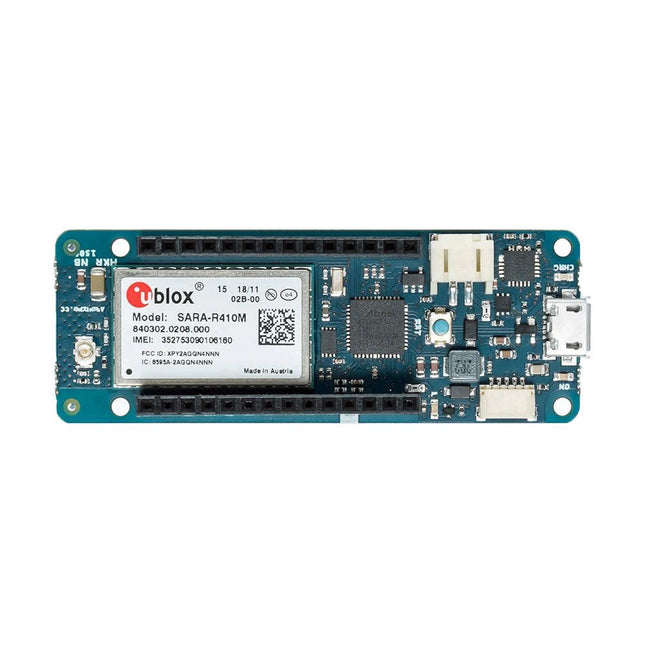
Arduino Arduino MKR NB 1500
De Arduino MKR NB 1500 stelt u in staat om uw volgende slimme project te bouwen.Altijd al een geautomatiseerd huis gewild? Of een slimme tuin? Welnu, vanaf nu is dat eenvoudig met de Arduino IoT Cloud-compatible boards. Hiermee kunt u apparaten onderling koppelen, data visualiseren, en uw projecten vanuit de hele wereld beheren en delen. Of u een beginner bent of een professional, we kunnen u een breed scala aan abonnementen bieden om u alle ondersteuning te geven die u nodig heeft.Voeg met de MKR NB 1500 Narrowband-communicatie toe aan uw project. Dat is een prima optie voor apparaten op afgelegen locaties zonder internetverbinding, of in situaties waarin geen stroom beschikbaar is zoals bij implementaties in het veld, meetsystemen op afstand, apparaten op zonne-energie of andere uitzonderlijke situaties.De hoofdprocessor van het board is de energiezuinige ARM Cortex-M0 32-bit SAMD21, net als in andere boards binnen de Arduino MKR-familie. De Narrowband-connectiviteit wordt uitgevoerd met een module van u-blox, de SARA-R410M-02B, een energiezuinige chipset die werkt op de verschillende banden van de IoT LTE-spectra. Bovendien wordt een veilige communicatie gegarandeerd met de Microchip ECC508 crypto-chip. Daarnaast bevat de kaart een acculader en een connector voor een externe antenne.Dit board is ontworpen voor wereldwijd gebruik en biedt connectiviteit op LTE Cat M1/NB1 banden 1, 2, 3, 4, 5, 8, 12, 13, 18, 19, 20, 25, 26, 28. Operators die diensten aanbieden in dit deel van het spectrum zijn onder andere: Vodafone, AT&T, T-Mobile USA, Telstra en Verizon.SpecificatiesDe Arduino MKR NB 1500 is gebaseerd op de SAMD21 microcontroller. Microcontroller SAMD21 Cortex-M0+ 32-bit low power ARM MCU (datasheet) Radiomodule u-blox SARA-R410M-02B (datasheet summary) Secure element ATECC508 (datasheet) Board voeding (USB/VIN) 5 V Ondersteunde accu’s Li-Po Single Cell, 3,7 V, minimaal 1500 mAh Bedrijfsspanning van het circuit 3,3 V Digitaal en/of pinnen 8 PWM pinnen 13 (0 .. 8, 10, 12, 18 / A3, 19 / A4) UART 1 SPI 1 I²C 1 Analoge ingangspennen 7 (ADC 8/10/12-bits) Analoge uitgangspennen 1 (DAC 10-bits) Externe interrupts 8 (0, 1, 4, 5, 6, 7, 8, 16 / A1, 17 / A2) Gelijkstroom per I/O-pin 7 mA Flash-geheugen 256 KB (intern) SRAM 32 KB EEPROM Nee Kloksnelheid 32.768 kHz (RTC), 48 MHz LED_BUILTIN 6 USB Full-speed USB device met embedded host Antenne versterking 2 dB Carrier frequentie LTE-banden 1, 2, 3, 4, 5, 8, 12, 13, 18, 19, 20, 25, 26, 28 Vermogensklasse (radio) LTE Cat. M1 / NB1: Klasse 3 (23 dBm) Data snelheid (LTE M1 halp-duplex) UL 375 kbps / DL 300 kbps Data snelheid (LTE NB1 full-duplex) UL 62,5 kbps / DL 27,2 kbps Actieve regio Multi regio Locatiebepaling van het board GNSS via modem Stroomverbruik (LTE M1) min 100 mA / max 190 mA Stroomverbruik (LTE NB1) min 60 mA / max 140 mA SIM-kaart MicroSIM (niet inbegrepen bij het board) Dimensies 67,6 x 25 mm Gewicht 32 gr Downloads Eagle-bestanden Schema Pinout
€ 94,95€ 47,50
Leden identiek
-
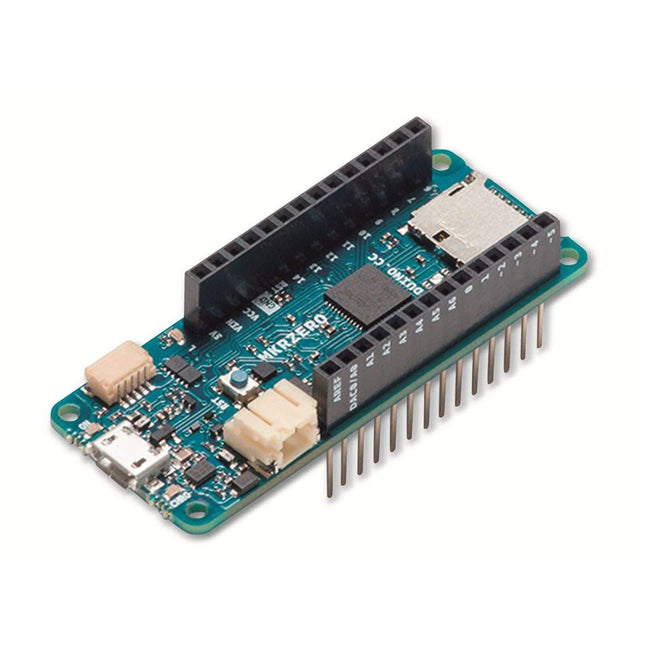
Arduino Arduino MKR Zero
De Arduino MKR Zero is een ontwikkel-board voor muziekmakers! Met een SD-kaart connector en speciale SPI-interfaces (SPI1) kunt u muziekbestanden afspelen zonder extra hardware.De MKR Zero brengt u de kracht van een Zero in het kleinere formaat van de MKR uitvoering. Het MKR Zero board is een prima educatief tool om 32-bits applicatieontwikkeling mee te leren. Hij heeft een ingebouwde SD-kaart connector en speciale SPI-interfaces (SPI1) waarmee u muziekbestanden kunt afspelen zonder extra hardware! Het board wordt bestuurd door Atmel's SAMD21 MCU, die een 32-bits ARM Cortex M0+ core heeft.Het board bevat alles wat nodig is om de microcontroller te ondersteunen. Sluit hem simpelweg met een micro-USB kabel aan op een computer, of voed hem met een Li-Po accu. Omdat er een verbinding zit tussen de accu en de analoog converter van het board kan de accuspanning ook worden gemonitord.Specificaties Microcontroller SAMD21 ARM Cortex-M0+ 32-bit low power Board voeding (USB/VIN) 5 V Ondersteunde accu’s Li-Po single cell, 3,7 V, minimaal 700 mAh Gelijkstroom voor 3,3 V pin 600 mA Gelijkstroom voor 5 V pin 600 mA Werkspanning van het board 3,3 V Digitale I/O pinnen 22 PWM pinnen 12 (0, 1, 2, 3, 4, 5, 6, 7, 8, 10, A3 - of 18 -, A4 - of 19) UART 1 SPI 1 I²C 1 Analoge ingangspinnen 7 (ADC 8/10/12-bits) Analoge uitgangspinnen 1 (DAC 10-bits) Externe interrupts 10 (0, 1, 4, 5, 6, 7, 8, A1 - of 16-, A2 - of 17) Gelijkstroom per I/O-pin 7 mA Flash geheugen 256 KB Flash-geheugen voor bootloader 8 KB SRAM 32 KB EEPROM Nee Kloksnelheid 32.768 kHz (RTC), 48 MHz LED_BUILTIN 32 Downloads Datasheet Eagle-bestanden Schema Fritzing Pinout
€ 36,95€ 18,50
Leden identiek
-
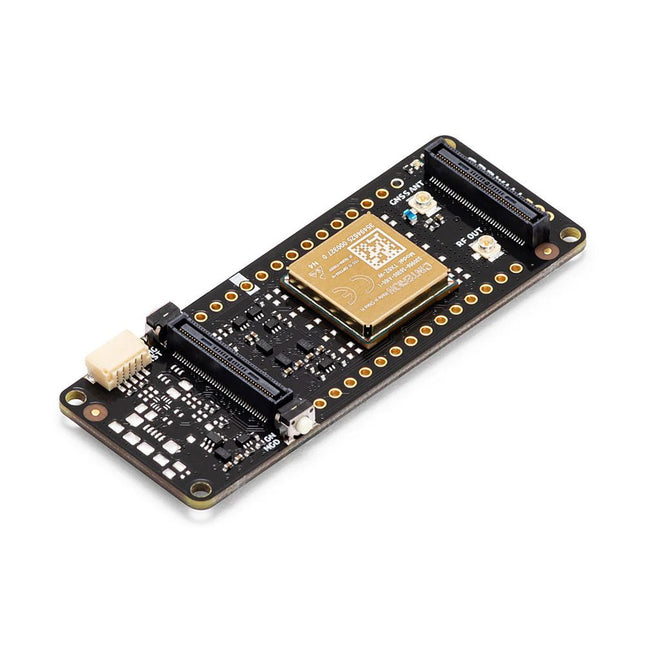
Arduino Arduino Pro Portenta Cat. M1/NB IoT GNSS Shield
De Portenta Cat. M1/NB IoT GNSS Shield kan van nut zijn bij het verbeteren van de connectiviteits-mogelijkheden van uw Portenta H7 toepassingen. Deze uitbreidingskaart maakt gebruik van de draadloze Cinterion TX62 module van Thales, ontworpen om aan efficiënte en energiezuinige IoT-toepassingen geoptimaliseerde bandbreedte en prestaties te bieden.De Portenta Cat. M1/NB IoT GNSS Shield is een uitbreiding op de krachtige edge-computing van de Portenta H7, om de ontwikkeling van asset tracking en remote monitoring mogelijk te maken in zowel industriële omgevingen, als ook in de landbouw, bij nutsbedrijven als bij smart city’s. De kaart biedt mobiele connectiviteit met zowel Cat. M1 als NB-IoT netwerken, met hierbij de optie om eSIM-technologie te gebruiken. Volg eenvoudig uw waardevolle goederen, in uw stad of wereldwijd, met een keuze uit GPS, GLONASS, Galileo of BeiDou.Functies Connectiviteitsopties wijzigen zonder het board te hoeven wijzigen Voeg NB-IoT, CAT. M1 en plaatsbepaling toe aan elk Portenta product Optie om een kleine multiprotocol router (WiFi - BT + NB-IoT/CAT. M1) te maken Verlaag de eisen qua communicatie-bandbreedte bij IoT-toepassingen aanzienlijk Module met laag stroomgebruik Ook compatibel met MKR-boards Monitoring op afstandIndustriële en agrarische bedrijven kunnen gebruik maken van de Portenta Cat. M1/NB IoT GNSS Shield voor het op afstand monitoren van gasdetectoren, optische sensoren, machine alarmsystemen, biologische bestrijdingsapparatuur en meer.Technologieleveranciers die smart city oplossingen bieden kunnen de kracht en de betrouwbaarheid van de Portenta H7 combineren met de Portenta Cat. M1/NB IoT GNSS Shield, om data uit te wisselen en taken te automatiseren, en om zo een geoptimaliseerd gebruik van middelen en een verbeterde gebruikerservaring te realiseren.Bewaking van bedrijfsmiddelenVoeg monitoring opties toe aan uw bedrijfsmiddelen door de prestaties en edge computing functies van de boards uit de Portenta familie te combineren. De Portenta Cat. M1/NB IoT GNSS Shield is ideaal voor het bewaken van waardevolle goederen, en voor het monitoren van industriële machines en apparatuur.Specificaties Connectiviteit Cinterion TX62 draadloze module; NB-IoT - LTE CAT. M1; 3GPP Rel. 14 Compliant Protocol LTE Cat. M1/NB1/NB2; UMTS BANDEN: 1 / 2 / 3 / 4 / 5 / 8 / 12 (17) / 13 / 18 / 19 / 20 / 25 / 26 / 27 / 28 / 66 / 71 / 85; LTE Cat. M1 DL: max. 300 kbps, UL: max. 1,1 Mbps; LTE Cat. NB1 DL: max. 27 kbps, UL: max. 63 kbps; LTE Cat. NB2 DL: max. 124 kbps, UL: max. 158 kbps Short messaging service (SMS) Point-to-point Mobile Terminated (MT) en Mobile Originated (MO) Text Mode; Protocol Data Unit (PDU) Mode Plaatsbepaling GNSS capability (GPS/BeiDou/Galileo/GLONASS) Overig Embedded IPv4 en IPv6 TCP/IP stack access; Internet services: TCP server/client, UDP client, DNS, Ping, HTTP client, FTP client, MQTT client Secure Connection met TLS/DTLS Secure Boot Dimensies 66 x 25,4 mm Bedrijfstemperatuur -40° C tot +85° C (-104° F tot 185°F) Downloads Datasheet Schema
€ 99,95€ 49,95
Leden identiek



















